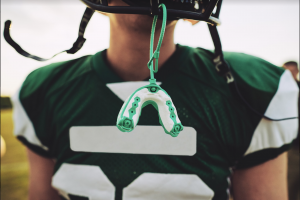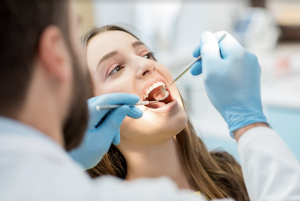
Then: You reached for a soda.
Now: You quench your thirst with water.
Why: Two out of three adults in the United States are overweight or obese, and 1 in 4 Americans get at least 200 calories a day from sugary drinks like soda. Since a 20-ounce regular soda has an average of 227 calories, cutting soda from your diet is an easy way to save on calories.
The calories in regular soda are not good for your health, but they are even worse for your teeth because those calories come from added sugar. A regular can of soda also contains about 12.5 teaspoons of added sugar, which is how much added sugar the FDA says people over the age of 3 should have throughout an entire day!
The swap is simple: Water. (Even better if it’s fluoridated!) Water contains no calories, no sugars and helps keep cavities away by washing away leftover food and keeping dry mouth at bay.
When You’re Craving Dessert
Then: You grabbed a cookie after dinner to feed your sweet tooth.
Now: You reach for a piece of sugarless gum.
Why: It’s a win-win: You can prevent dessert remorse and clean your teeth at the same time. Waiting about 20 minutes after a meal helps your body determine if it’s really still hungry. Studies also show that chewing sugarless gum for 20 minutes after eating can reduce your risk of cavities.
If you, your family or friends need dental care, we would be honored to provide you with state-of-the-art dental care in our modern dental practice. Refer someone you love to someone you trust!
Presented as a service to the community by Doctors Hoover and Yanda,
39 Milford Drive, Hudson, Ohio 44236. 330-650-0360. www.drshooverandyanda.com

 Fruits and vegetables: These should cover half your plate at meals. They are high in water and fiber, which balance the sugars they contain and help to clean your teeth. These foods also help stimulate saliva production, which washes harmful acids and food particles away from teeth and helps neutralize acid, protecting teeth from cavities.
Fruits and vegetables: These should cover half your plate at meals. They are high in water and fiber, which balance the sugars they contain and help to clean your teeth. These foods also help stimulate saliva production, which washes harmful acids and food particles away from teeth and helps neutralize acid, protecting teeth from cavities.

 Findings of the analysis, based on a review of medical and dental exam records of more than 3,600 people with high blood pressure, reveal that those with healthier gums have lower blood pressure and responded better to blood pressure-lowering medications, compared with individuals who have gum disease. People with periodontal disease were 20 percent less likely to reach healthy blood pressure ranges, compared with patients in good oral health.
Findings of the analysis, based on a review of medical and dental exam records of more than 3,600 people with high blood pressure, reveal that those with healthier gums have lower blood pressure and responded better to blood pressure-lowering medications, compared with individuals who have gum disease. People with periodontal disease were 20 percent less likely to reach healthy blood pressure ranges, compared with patients in good oral health. of mouthguards: the “boil and bite” type and the custom-made type. The “boil and bite” mouthguard is fitted by the athlete him or herself by dipping it into boiling water for a couple of minutes, and then forming it to the teeth while it is soft and moldable. This is the less costly type, can be re-molded by reboiling it if need be and for many people it works fine. Some people require a more precise fit than a “boil and bite” mouthguard can provide. For them, their dentist can make a custom-made mouthguard. The dentist makes impressions of the teeth and a laboratory-processed mouthguard is then fabricated. It fits much more comfortably because of the custom-fit.
of mouthguards: the “boil and bite” type and the custom-made type. The “boil and bite” mouthguard is fitted by the athlete him or herself by dipping it into boiling water for a couple of minutes, and then forming it to the teeth while it is soft and moldable. This is the less costly type, can be re-molded by reboiling it if need be and for many people it works fine. Some people require a more precise fit than a “boil and bite” mouthguard can provide. For them, their dentist can make a custom-made mouthguard. The dentist makes impressions of the teeth and a laboratory-processed mouthguard is then fabricated. It fits much more comfortably because of the custom-fit. 

 Begin cleaning your baby’s mouth during the first few days after birth by wiping the gums with a clean, moist gauze pad or washcloth. As soon as teeth appear, decay can occur. A baby’s front four teeth usually push through the gums at about 6 months of age, although some children don’t have their first tooth until 12 or 14 months.
Begin cleaning your baby’s mouth during the first few days after birth by wiping the gums with a clean, moist gauze pad or washcloth. As soon as teeth appear, decay can occur. A baby’s front four teeth usually push through the gums at about 6 months of age, although some children don’t have their first tooth until 12 or 14 months. Most children have a full set of 20 primary teeth by the time they are 3. Every child is different, but usually the first teeth to come in are located in the top and bottom front of their mouth. The remaining teeth generally fill in from front to back, ending with baby’s first molars.
Most children have a full set of 20 primary teeth by the time they are 3. Every child is different, but usually the first teeth to come in are located in the top and bottom front of their mouth. The remaining teeth generally fill in from front to back, ending with baby’s first molars.